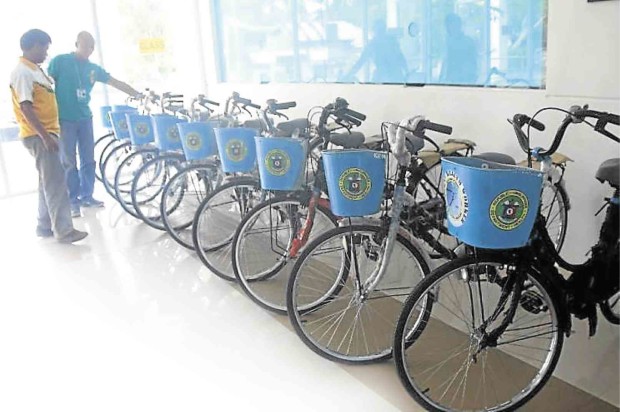
BIKE FOR LIFE Barangay health workers in Southern Tagalog region will soon use these bicycles to deliver medical aid to remote areas.CONTRIBUTED PHOTO
RUDY Bungay, 62, has been a volunteer health worker most his life. Each time duty calls, he had to walk 2 to 3 kilometers to attend to an ailing neighbor.
“Sometimes, I come home late at night that my family starts worrying where I’ve been,” he said.
Bungay is one of only two barangay health workers in Sitio Matanggule in the island village of Bancalan in Balabac town, Palawan province. The village has about 500 households, with the nearest health facility more than an hour away by pump boat.
When Bancalan was struck with a diarrhea outbreak in 2004, Bungay remembered attending to more than 100 people who had to be put on dextrose. “I’ve been thinking of quitting the job, but I worry about the people here,” he said. “Besides, I’m still supporting two children in college.”
Thanks to a bicycle given by the Department of Health (DOH) in Mimaropa (Mindoro, Marinduque, Romblon, Palawan), Bungay’s problem of reaching remote areas on his island has somewhat been eased.
Good exercise, too
“It made [my job] a lot easier. Biking is also a good exercise for me,” said Bungay, one of the first beneficiaries of the project.
In June, the DOH gave away 13 bicycles to barangay health workers in Marinduque province and seven in Occidental Mindoro province. The project aims to give away 45 bicycles in the region.
Dr. Eduardo Janairo, regional health director, said the bicycles were meant for those assigned to hard-to-reach areas, for instance in the upland villages in the Mindoro provinces and Palawan, to serve indigenous peoples’ communities.
Janairo said the department bought new bikes, each costing at least P10,000, and “redesigned” them with tires strong enough to withstand rugged roads or river-crossing. The bikes have baskets and hampers, marked with the DOH logo, where health workers could place their sphygmomanometers, glucometers and medical kits.
DOH records show that the provinces of Mimaropa have 13,000 barangay health workers, of which 99 percent are women.
Health workers receive stipends, the amount of which depends on their local government’s income. Some receive a low of P50 a day, which is collected at the end of each year, or P1,000 every quarter. Bungay receives P700 a month.
At least 77 rural health units are run by local governments, though most of these are located in the region’s mainland.
The delivery of health services is even more challenging given Mimaropa’s geography.
While motorcycles are a common mode of transportation, motor vehicles are expensive than bicycles, Janairo said. “There are also areas where the roads are small and narrow or in some cases, they have to cross rivers,” he said.
With a relatively small population (2,744,671 as of 2010, according to the Philippine Statistics Authority), the DOH regional office was allocated a budget of only P39 million for operating expenses this year.
Janairo said giving barangay health workers bicycles would shorten time to respond to emergencies in local communities.
“We need to make available everything a barangay health worker requires for them to … keep the community healthy as they go house-to-house to provide medical assistance,” he said.